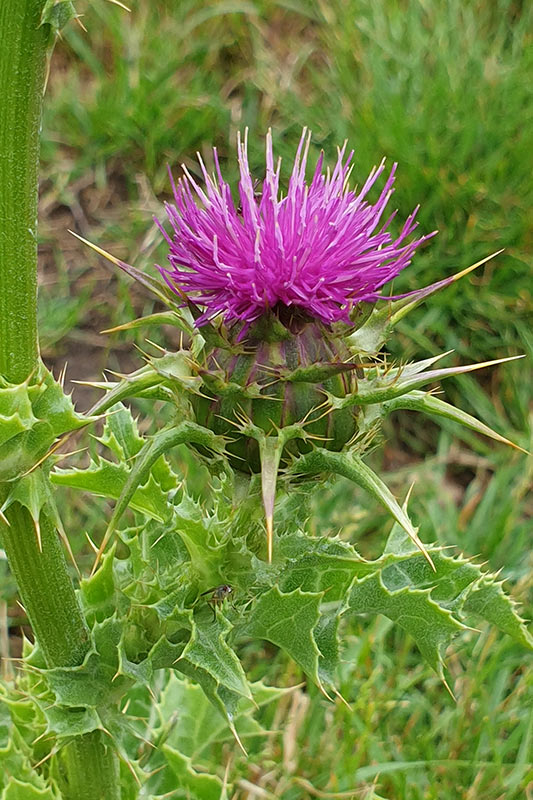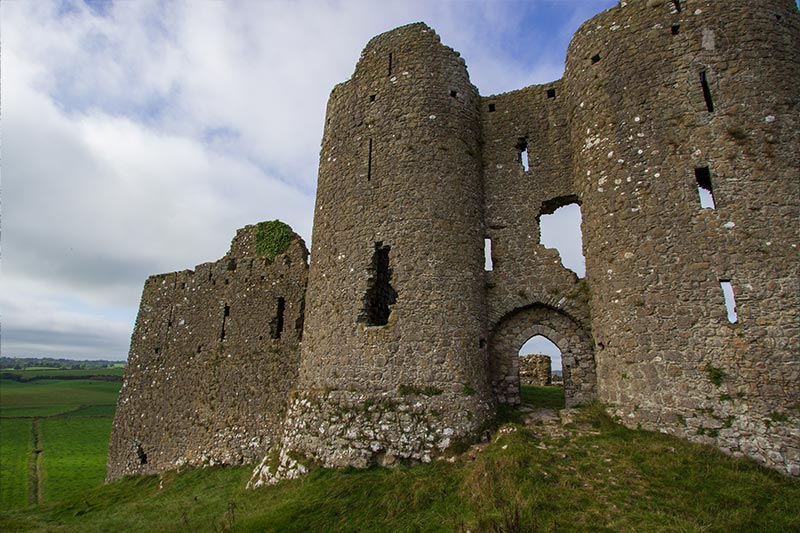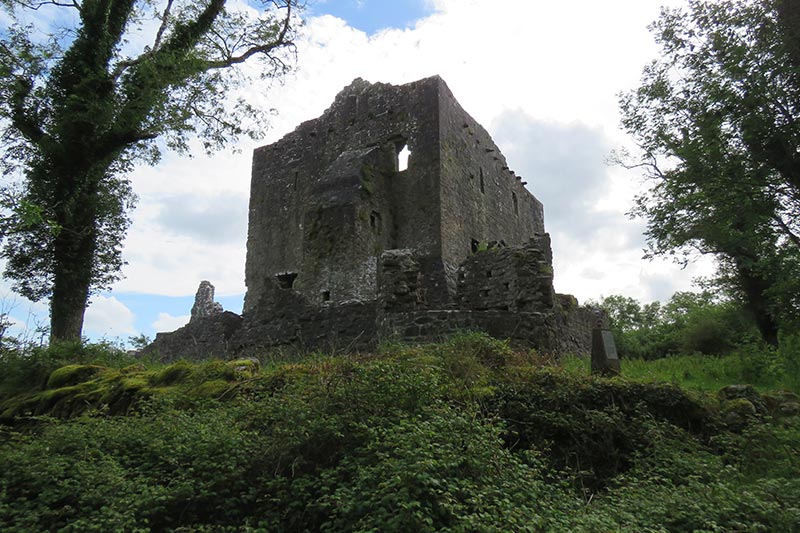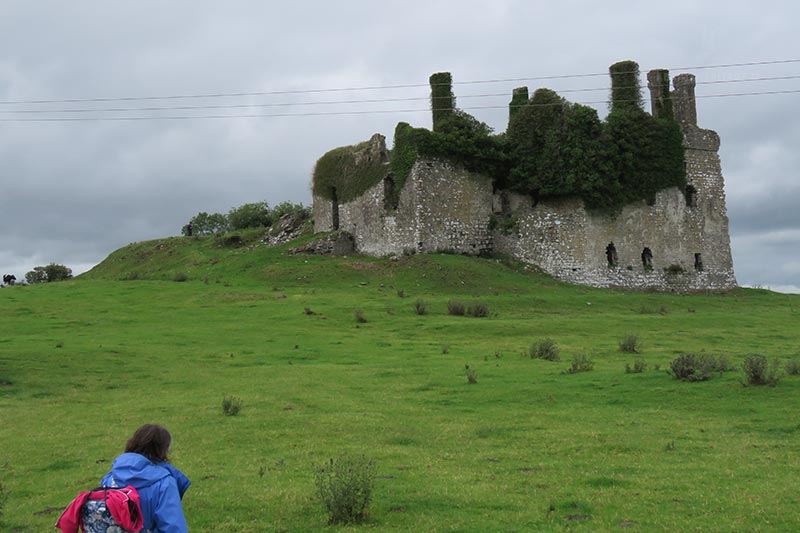Amplify Archaeology Podcast

Green Heritage Relict Plants and Medieval Women – Amplify Archaeology Podcast – Episode 27
Green Heritage Relict Plants and Medieval Women
Dig into the Story of Relict Plants and Women & Gender in Medieval Ireland in Amplify Archaeology Podcast Episode 27 with Dr Karen Dempsey
Green Heritage Relict Plants and Medieval Women
Dig into the Story of Relict Plants and Women & Gender in Medieval Ireland in Amplify Archaeology Podcast Episode 27 with Dr Karen Dempsey
When we visit medieval castles, we inevitably focus on the grandeur and romance of the ruins of the stone fortresses, but stories bloom in quiet corners. In this fascinating discussion with Dr Karen Dempsey, we discuss green heritage, relict plants, and women in medieval Ireland.
In this episode of the Amplify Archaeology Podcast, Neil had the opportunity to chat with Dr. Karen Dempsey, a researcher with the Department of Archaeology at NUIG. Karen has been carrying fascinating research with the project ‘Sowing Seeds of Interdisciplinary Work’. The project, funded by the Castle Studies Trust, was a multidisciplinary way of looking at life at medieval castles by studying ‘relict plants’. These plants are the descendants of those introduced by the people who built and lived in the castles. They provide insights into so many aspects of medieval life, including diet, medicine, fashion and belief.
Four geographically diverse but culturally similar medieval castles were selected for botanical surveys: Adare. Co. Limerick, Castleroche, Co. Louth, Carbury, Co. Kildare and Castlecarra, Co. Mayo. Together with detailed analysis of archaeological, historical and architectural details of these castles, the study of the botany has enriched our understanding of the ‘green’ lives of people in the past but also showcased the life of castles – as medieval residences but also as romantic ruins in later landscapes.
This is a fascinating discussion that digs into the results of the project and the chat ranges from castles and conquests, women and gender to gardening, colonialism, spirituality and nature. I hope you enjoy the episode!
.fusion-gallery-1 .fusion-gallery-image {border:0px solid #f6f6f6;}





AMPLIFY ARCHAEOLOGY PODCAST
.fusion-body .fusion-builder-column-5{width:100% !important;margin-top : 10px;margin-bottom : 20px;}.fusion-builder-column-5 > .fusion-column-wrapper {padding-top : 0px !important;padding-right : 0px !important;margin-right : 1.92%;padding-bottom : 0px !important;padding-left : 0px !important;margin-left : 1.92%;}@media only screen and (max-width:1024px) {.fusion-body .fusion-builder-column-5{width:100% !important;order : 0;}.fusion-builder-column-5 > .fusion-column-wrapper {margin-right : 1.92%;margin-left : 1.92%;}}@media only screen and (max-width:640px) {.fusion-body .fusion-builder-column-5{width:100% !important;order : 0;}.fusion-builder-column-5 > .fusion-column-wrapper {margin-right : 1.92%;margin-left : 1.92%;}}
AMPLIFY ARCHAEOLOGY PODCAST
.fusion-body .fusion-builder-column-6{width:100% !important;margin-top : 10px;margin-bottom : 20px;}.fusion-builder-column-6 > .fusion-column-wrapper {padding-top : 0px !important;padding-right : 0px !important;margin-right : 1.92%;padding-bottom : 0px !important;padding-left : 0px !important;margin-left : 1.92%;}@media only screen and (max-width:1024px) {.fusion-body .fusion-builder-column-6{width:100% !important;order : 1;}.fusion-builder-column-6 > .fusion-column-wrapper {margin-right : 1.92%;margin-left : 1.92%;}}@media only screen and (max-width:640px) {.fusion-body .fusion-builder-column-6{width:100% !important;order : 1;}.fusion-builder-column-6 > .fusion-column-wrapper {margin-right : 1.92%;margin-left : 1.92%;}}.fusion-body .fusion-builder-column-7{width:100% !important;margin-top : 70px;margin-bottom : 40px;}.fusion-builder-column-7 > .fusion-column-wrapper {padding-top : 0px !important;padding-right : 0px !important;margin-right : 1.92%;padding-bottom : 0px !important;padding-left : 0px !important;margin-left : 1.92%;}@media only screen and (max-width:1024px) {.fusion-body .fusion-builder-column-7{width:100% !important;order : 2;}.fusion-builder-column-7 > .fusion-column-wrapper {margin-right : 1.92%;margin-left : 1.92%;}}@media only screen and (max-width:640px) {.fusion-body .fusion-builder-column-7{width:100% !important;order : 2;}.fusion-builder-column-7 > .fusion-column-wrapper {margin-right : 20px;margin-left : 20px;}}
Title: Green Heritage, Relict Plants, and Medieval Women
Duration: 53 mins.
Summary:
In this fascinating discussion with Dr Karen Dempsey, we discuss green heritage, relict plants, and women in medieval Ireland.
.fusion-body .fusion-builder-column-8{width:50% !important;margin-top : 0px;margin-bottom : 20px;}.fusion-builder-column-8 > .fusion-column-wrapper {padding-top : 0px !important;padding-right : 10 !important;margin-right : 3.84%;padding-bottom : 0px !important;padding-left : 0px !important;margin-left : 3.84%;}@media only screen and (max-width:1024px) {.fusion-body .fusion-builder-column-8{width:100% !important;order : 3;}.fusion-builder-column-8 > .fusion-column-wrapper {margin-right : 1.92%;margin-left : 1.92%;}}@media only screen and (max-width:640px) {.fusion-body .fusion-builder-column-8{width:100% !important;order : 3;}.fusion-builder-column-8 > .fusion-column-wrapper {margin-right : 1.92%;margin-left : 1.92%;}}.fusion-body .fusion-flex-container.fusion-builder-row-5{ padding-top : 50px;margin-top : 0px;padding-right : 0px;padding-bottom : 30px;margin-bottom : 0px;padding-left : 0px;}Green Heritage, Relict Plants and Medieval Women – Key Discussion Points
- What drew Karen to study the medieval period? – 1 min 01 secs
- What are relict plants? – 3 min 06 secs
- Apart from food, what else were plants used for in medieval Ireland? – 4 min 35 secs
- Did the use of plants change after the arrival of the Normans? Can plants be colonial? – 6 min 49 secs
- The Relict Plants Projects – 8 min 25 secs
- Results at Castleroche – 12 min 50 secs
- Results at Adare Castle – 17 min 24 secs
- Results at Castle Carra – 20 min 07 secs
- Results at Carbury Castle – 22 min 43 secs
- The importance of hedgerows and ‘green heritage’ – 25 mins 29 secs
- Gardening, Meaning and Living Heritage – 26 min 12 secs
- Does the type of plant we choose to grow say something about society, today and in the past? – 30 min 26 secs
- Plants and spirituality – 34 mins 15 secs
- Women and medieval Ireland – 40 min 28 secs
- Medieval women in the historical record – 45 mins 20 secs
- Where can people learn more about the project – 46 min 57 secs
Show notes and links to further information
- You can discover more about the Sowing Seeds Project here.
- The fascinating results of the project are discussed here, and you can read the final reports here.
- You can find a brilliant talk by Karen for Heritage Week, along with all the site videos on YouTube.
- You can also see Karen addressing gender in archaeology in this video: Gendering the Narrative of Research Frameworks.
- The brilliant graphic novel that Karen mentioned on Gender and Archaeology can be found at Sidestone.
- Archaeology and Gender in Europe – a group within the community of the European Association of Archaeologists can be found here.
- Karen also has some brilliant articles if you’d like to dig deeper into some of these subjects. These include:
Dempsey, K. 2021. Tending the ‘Contested’ Castle Garden: Sowing Seeds of Feminist Thought. Cambridge Archaeological Journal, 1–15.
Dempsey, K. 2021. Herstory: exploring the material life of Gundrada de Warenne. In E. Bérat, R. Hardie and I. Dumitrescu (ed) Relations of Power: Women’s Networks in the Middle Ages. Studien zu Macht und Herrschaft. V&R unipress, University of Bonn Press. pp. 169-197
Dempsey, K., Gilchrist, R., Ashbee, J., Stones, S. & Sagrott, S. 2020. Beyond the martial façade: gender, heritage and medieval castles, International Journal of Heritage Studies, 26:4, pp. 352-369 - You can hear more on the origins and architecture of Irish Castles in Episode 3 of Amplify Archaeology Podcast with Professor Tadhg O’Keeffe.
- I highly recommend Braiding Sweetgrass by Robin Wall Kimmerer, it’s one of my favourite books of recent years. If you’re in Ireland you’ll find it at a good price and free post at Kennys.ie.
- And if you’re interested in exploring more on the connections between our spiritual and natural world you might enjoy Emergence Magazine Podcast. Always worth a listen.
- Please do leave us a review if you can, or share the episode using the podcast #AmplifyArchaeology – it really does help us out so I’d be very grateful.
- If you’d like to dig deeper into the stories of Ireland you’ll love our new membership service Tuatha. Online courses, places to visit, itineraries for great days out and more! Sign up here.
Amplify Archaeology Podcast is also available on
.fusion-gallery-2 .fusion-gallery-image {border:0px solid #f6f6f6;}




 .fusion-body .fusion-builder-column-10{width:100% !important;margin-top : 30px;margin-bottom : 0px;}.fusion-builder-column-10 > .fusion-column-wrapper {padding-top : 0px !important;padding-right : 0px !important;margin-right : 1.92%;padding-bottom : 0px !important;padding-left : 0px !important;margin-left : 1.92%;}@media only screen and (max-width:1024px) {.fusion-body .fusion-builder-column-10{width:100% !important;order : 5;}.fusion-builder-column-10 > .fusion-column-wrapper {margin-right : 1.92%;margin-left : 1.92%;}}@media only screen and (max-width:640px) {.fusion-body .fusion-builder-column-10{width:100% !important;order : 5;margin-top : 20px;margin-bottom : 0px;}.fusion-builder-column-10 > .fusion-column-wrapper {margin-right : 1.92%;margin-left : 1.92%;}}.fusion-body .fusion-flex-container.fusion-builder-row-7{ padding-top : 10px;margin-top : 0px;padding-right : 0px;padding-bottom : 10px;margin-bottom : 0px;padding-left : 0px;}
.fusion-body .fusion-builder-column-10{width:100% !important;margin-top : 30px;margin-bottom : 0px;}.fusion-builder-column-10 > .fusion-column-wrapper {padding-top : 0px !important;padding-right : 0px !important;margin-right : 1.92%;padding-bottom : 0px !important;padding-left : 0px !important;margin-left : 1.92%;}@media only screen and (max-width:1024px) {.fusion-body .fusion-builder-column-10{width:100% !important;order : 5;}.fusion-builder-column-10 > .fusion-column-wrapper {margin-right : 1.92%;margin-left : 1.92%;}}@media only screen and (max-width:640px) {.fusion-body .fusion-builder-column-10{width:100% !important;order : 5;margin-top : 20px;margin-bottom : 0px;}.fusion-builder-column-10 > .fusion-column-wrapper {margin-right : 1.92%;margin-left : 1.92%;}}.fusion-body .fusion-flex-container.fusion-builder-row-7{ padding-top : 10px;margin-top : 0px;padding-right : 0px;padding-bottom : 10px;margin-bottom : 0px;padding-left : 0px;}Dig into more stories with Amplify Archaeology Podcast
.fusion-body .fusion-builder-column-11{width:100% !important;margin-top : 0px;margin-bottom : 20px;}.fusion-builder-column-11 > .fusion-column-wrapper {padding-top : 0px !important;padding-right : 0px !important;margin-right : 1.92%;padding-bottom : 0px !important;padding-left : 0px !important;margin-left : 1.92%;}@media only screen and (max-width:1024px) {.fusion-body .fusion-builder-column-11{width:100% !important;order : 0;}.fusion-builder-column-11 > .fusion-column-wrapper {margin-right : 1.92%;margin-left : 1.92%;}}@media only screen and (max-width:640px) {.fusion-body .fusion-builder-column-11{width:100% !important;order : 0;}.fusion-builder-column-11 > .fusion-column-wrapper {margin-right : 1.92%;margin-left : 1.92%;}}.fusion-body .fusion-flex-container.fusion-builder-row-8{ padding-top : 40px;margin-top : 0px;padding-right : 0px;padding-bottom : 10px;margin-bottom : 0px;padding-left : 0px;}.fusion-imageframe.imageframe-1{ margin-top : 15px;margin-right : 5px;margin-bottom : 10px;}
Episode 23 with Dr. Marion Dowd
Cave Archaeology
Amplify Archaeology
.fusion-body .fusion-builder-column-12{width:33.333333333333% !important;margin-top : 0px;margin-bottom : 20px;}.fusion-builder-column-12 > .fusion-column-wrapper {padding-top : 0px !important;padding-right : 0px !important;margin-right : 5.76%;padding-bottom : 0px !important;padding-left : 0px !important;margin-left : 5.76%;}.fusion-flex-container .fusion-row .fusion-builder-column-12 > .fusion-column-inner-bg { margin-right:5.76%;margin-left:5.76%; }@media only screen and (max-width:1024px) {.fusion-body .fusion-builder-column-12{width:50% !important;order : 0;}.fusion-builder-column-12 > .fusion-column-wrapper {margin-right : 3.84%;margin-left : 3.84%;}.fusion-flex-container .fusion-row .fusion-builder-column-12 > .fusion-column-inner-bg { margin-right:3.84%;margin-left:3.84%; }}@media only screen and (max-width:640px) {.fusion-body .fusion-builder-column-12{width:100% !important;order : 0;}.fusion-builder-column-12 > .fusion-column-wrapper {margin-right : 1.92%;margin-left : 1.92%;}.fusion-flex-container .fusion-row .fusion-builder-column-12 > .fusion-column-inner-bg { margin-right:1.92%;margin-left:1.92%; }}.fusion-imageframe.imageframe-2{ margin-top : 15px;margin-right : 5px;margin-bottom : 10px;}
Episode 5 with Dr. Meriel McClatchie & team
Bloom; the Past in Plant Remains
Amplify Archaeology
.fusion-body .fusion-builder-column-13{width:33.333333333333% !important;margin-top : 0px;margin-bottom : 20px;}.fusion-builder-column-13 > .fusion-column-wrapper {padding-top : 0px !important;padding-right : 0px !important;margin-right : 5.76%;padding-bottom : 0px !important;padding-left : 0px !important;margin-left : 5.76%;}.fusion-flex-container .fusion-row .fusion-builder-column-13 > .fusion-column-inner-bg { margin-right:5.76%;margin-left:5.76%; }@media only screen and (max-width:1024px) {.fusion-body .fusion-builder-column-13{width:50% !important;order : 0;}.fusion-builder-column-13 > .fusion-column-wrapper {margin-right : 3.84%;margin-left : 3.84%;}.fusion-flex-container .fusion-row .fusion-builder-column-13 > .fusion-column-inner-bg { margin-right:3.84%;margin-left:3.84%; }}@media only screen and (max-width:640px) {.fusion-body .fusion-builder-column-13{width:100% !important;order : 0;}.fusion-builder-column-13 > .fusion-column-wrapper {margin-right : 1.92%;margin-left : 1.92%;}.fusion-flex-container .fusion-row .fusion-builder-column-13 > .fusion-column-inner-bg { margin-right:1.92%;margin-left:1.92%; }}.fusion-imageframe.imageframe-3{ margin-top : 15px;margin-right : 5px;margin-bottom : 10px;}
Episode 3 with Prof. Tadhg O’Keeffe
Irish Castles
Amplify Archaeology
.fusion-body .fusion-builder-column-14{width:33.333333333333% !important;margin-top : 0px;margin-bottom : 20px;}.fusion-builder-column-14 > .fusion-column-wrapper {padding-top : 0px !important;padding-right : 0px !important;margin-right : 5.76%;padding-bottom : 0px !important;padding-left : 0px !important;margin-left : 5.76%;}.fusion-flex-container .fusion-row .fusion-builder-column-14 > .fusion-column-inner-bg { margin-right:5.76%;margin-left:5.76%; }@media only screen and (max-width:1024px) {.fusion-body .fusion-builder-column-14{width:50% !important;order : 0;}.fusion-builder-column-14 > .fusion-column-wrapper {margin-right : 3.84%;margin-left : 3.84%;}.fusion-flex-container .fusion-row .fusion-builder-column-14 > .fusion-column-inner-bg { margin-right:3.84%;margin-left:3.84%; }}@media only screen and (max-width:640px) {.fusion-body .fusion-builder-column-14{width:100% !important;order : 0;}.fusion-builder-column-14 > .fusion-column-wrapper {margin-right : 1.92%;margin-left : 1.92%;}.fusion-flex-container .fusion-row .fusion-builder-column-14 > .fusion-column-inner-bg { margin-right:1.92%;margin-left:1.92%; }}.fusion-body .fusion-flex-container.fusion-builder-row-9{ padding-top : 0px;margin-top : 0px;padding-right : 0px;padding-bottom : 0px;margin-bottom : 0px;padding-left : 0px;}We'd love it if you'd consider sharing this episode with a friend.fusion-sharing-box-1 h4{margin-bottom:0 !important;}.fusion-sharing-box-1{flex-direction:row !important;}.sharingbox-shortcode-icon-wrapper-1 span.sharingbox-shortcode-icon-separator{border-right-width:0px !important;}@media only screen and (max-width:1024px){.fusion-sharing-box-1 h4{margin-right:0.5em !important;margin-bottom:0 !important;}.sharingbox-shortcode-icon-wrapper-1{width:auto !important;justify-content:flex-end !important;}.fusion-sharing-box-1{align-items:center !important;} }@media only screen and (max-width:640px){.fusion-sharing-box-1{flex-direction: column !important;align-items:center !important;}.fusion-sharing-box-1 h4{margin-bottom:revert !important;}.sharingbox-shortcode-icon-wrapper-1{width:100% !important;justify-content:space-between !important;} }
#mc_embed_signup{background:#fff; clear:left; font:14px Helvetica,Arial,sans-serif; }
/* Add your own Mailchimp form style overrides in your site stylesheet or in this style block.
We recommend moving this block and the preceding CSS link to the HEAD of your HTML file. */
#mc-embedded-subscribe-form input[type=checkbox]{display: inline; width: auto;margin-right: 10px;}
#mergeRow-gdpr {margin-top: 20px;}
#mergeRow-gdpr fieldset label {font-weight: normal;}
#mc-embedded-subscribe-form .mc_fieldset{border:none;min-height: 0px;padding-bottom:0px;}
Subscribe to our Abarta Heritage mailing list to get exclusive insights and offers
* indicates required
Email Address *
First Name *
Last Name *
Marketing Permissions
Abarta Heritage will use the information you provide on this form to be in touch with you and to provide updates and marketing. Please let us know all the ways you would like to hear from us:
Email Customized online advertising
You can change your mind at any time by clicking the unsubscribe link in the footer of any email you receive from us, or by contacting us at team@abartaheritage.ie. We will treat your information with respect. For more information about our privacy practices please visit our website. By clicking below, you agree that we may process your information in accordance with these terms.
We use Mailchimp as our marketing platform. By clicking below to subscribe, you acknowledge that your information will be transferred to Mailchimp for processing. Learn more about Mailchimp's privacy practices here.
.fusion-body .fusion-builder-column-16{width:100% !important;margin-top : 0px;margin-bottom : 20px;}.fusion-builder-column-16 > .fusion-column-wrapper {padding-top : 0px !important;padding-right : 0px !important;margin-right : 1.92%;padding-bottom : 0px !important;padding-left : 0px !important;margin-left : 1.92%;}@media only screen and (max-width:1024px) {.fusion-body .fusion-builder-column-16{width:100% !important;order : 0;}.fusion-builder-column-16 > .fusion-column-wrapper {margin-right : 1.92%;margin-left : 1.92%;}}@media only screen and (max-width:640px) {.fusion-body .fusion-builder-column-16{width:100% !important;order : 0;}.fusion-builder-column-16 > .fusion-column-wrapper {margin-right : 1.92%;margin-left : 1.92%;}}.fusion-body .fusion-flex-container.fusion-builder-row-11{ padding-top : 0px;margin-top : 0px;padding-right : 0px;padding-bottom : 0px;margin-bottom : 0px;padding-left : 0px;}
The post Green Heritage Relict Plants and Medieval Women – Amplify Archaeology Podcast – Episode 27 appeared first on Abarta Heritage Home.






 Visit Podcast Website
Visit Podcast Website RSS Podcast Feed
RSS Podcast Feed Subscribe
Subscribe
 Add to MyCast
Add to MyCast